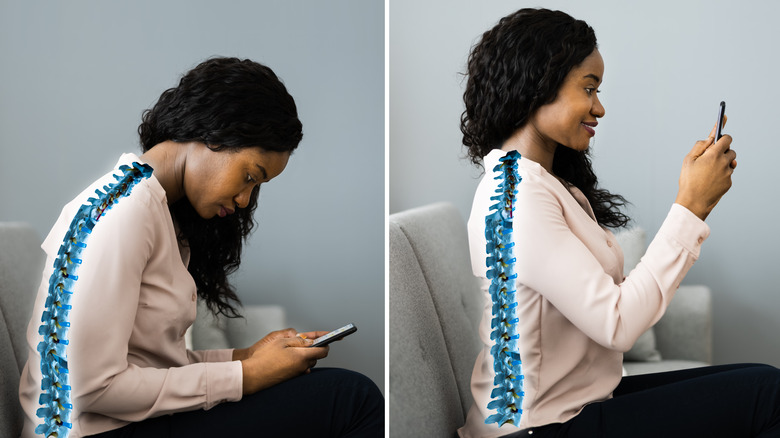The Proper Way You Should Really Be Sitting For Good Posture
Be honest, have you ever found yourself slouching over while watching television, or staring down at your phone for extended periods of time? If so, you're not the only one. We've all been there. Luckily, it's never too late to improve your posture. Good posture involves training your body to use the least amount of muscle and ligament strain while standing, walking, or sitting, so in return, you can place less strain on weight-bearing activities, according to Cleveland Clinic.
With that being said, a healthy sitting posture is more than just sitting up straight. In fact, research suggests it can influence how other people view us and even boost our confidence (per ScienceDaily).
In order to sit correctly, movement coach and manual therapist, Aaron Alexander, recommends making sure your hips are higher up than the height of your knees when sitting (via MindBodyGreen). Although, some specialists recommend your knees at hip height or slightly higher (via Cleveland Clinic). Regardless of the chosen method, the idea is that you want a good support system from the ground up. As for your feet, make sure to keep them flat on the floor. MindBodyGreen even suggests taking a moment to practice nasal breathing to increase your airflow.
Ultimately you'll want to, "imagine there's a little string in the back of your head, slowly drawing your head up toward the ceiling. Use your visual muscles and look up as opposed to looking down all the time," explains Alexander to MindBodyGreen.
What causes poor posture?
If truth be told, there are many reasons for poor posture. From slumping over while binge-watching your favorite Netflix series, and working on a laptop to constantly carrying hefty items or equipment (i.e. heavy groceries, boxes) — all of these activities can cause poor posture according to Harvard Health Publishing.
On top of all the extra weight on your back, weak abdomen and back muscles may also lead to poor posture. In severe cases, osteoporosis may be the culprit. Those with osteoporosis have fragile bones, which break, causing the body to take a hunched stance or stooped posture (via Bone Health & Osteoporosis Foundation). When this breakage occurs, it's called compression fractures. However, when the hunching forms it's known as kyphosis.
Poor posture can also lead to other bodily aches and pains, such as pain in the neck, headaches, difficulty breathing, trouble walking, and back pain (per Harvard Health Publishing). In fact, the 1994 article published in The New England Journal of Medicine explains that low back pain affects 31 million Americans at some point in their life.
Along with altering your sitting posture, Harvard Health Publishing recommends adding in some stretching and strengthening exercises to work the core, upper back, and chest muscles. In any case, be sure to speak with your doctor if you're experiencing severe discomfort.


